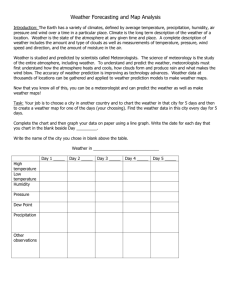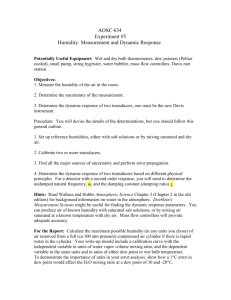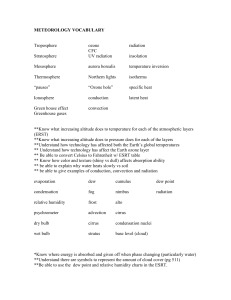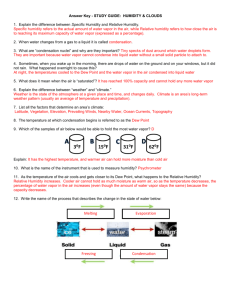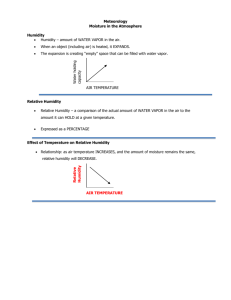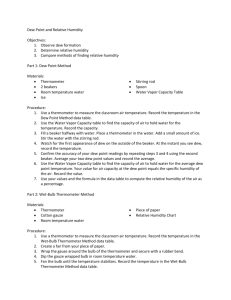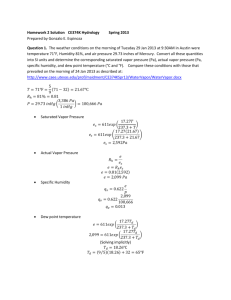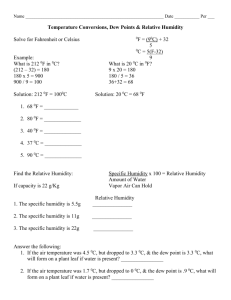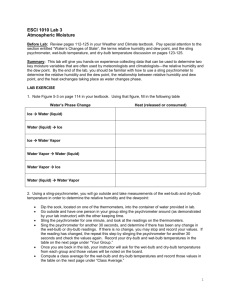DEW POINT LAB
advertisement
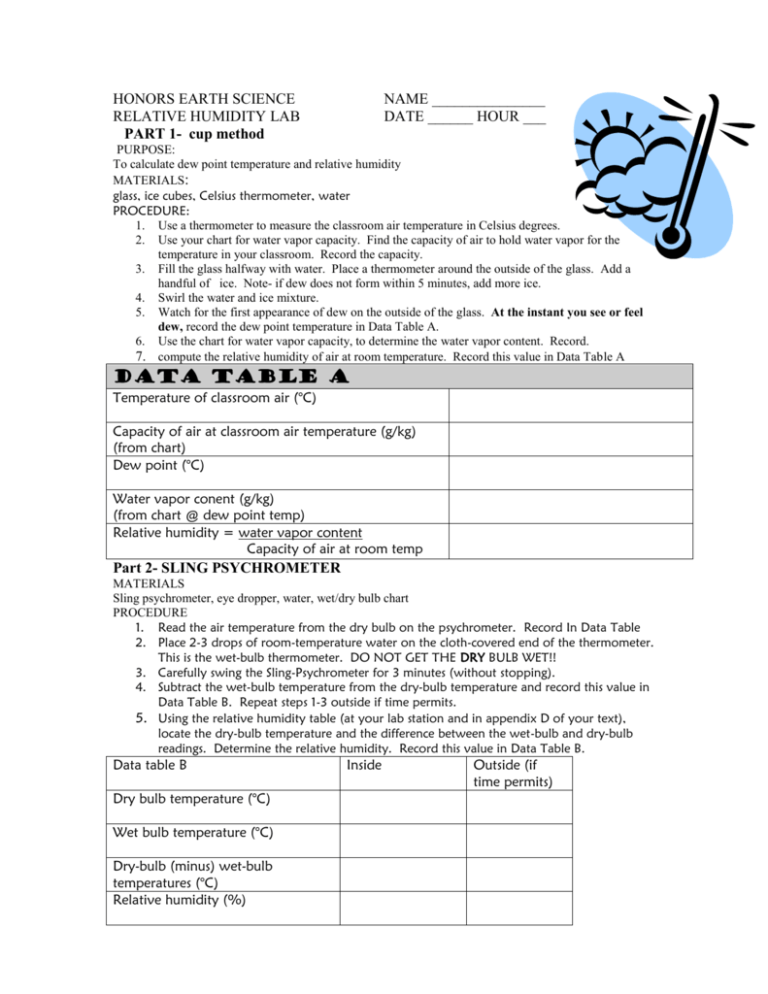
HONORS EARTH SCIENCE RELATIVE HUMIDITY LAB PART 1- cup method NAME _______________ DATE ______ HOUR ___ PURPOSE: To calculate dew point temperature and relative humidity MATERIALS: glass, ice cubes, Celsius thermometer, water PROCEDURE: 1. Use a thermometer to measure the classroom air temperature in Celsius degrees. 2. Use your chart for water vapor capacity. Find the capacity of air to hold water vapor for the temperature in your classroom. Record the capacity. 3. Fill the glass halfway with water. Place a thermometer around the outside of the glass. Add a handful of ice. Note- if dew does not form within 5 minutes, add more ice. 4. Swirl the water and ice mixture. 5. Watch for the first appearance of dew on the outside of the glass. At the instant you see or feel dew, record the dew point temperature in Data Table A. 6. Use the chart for water vapor capacity, to determine the water vapor content. Record. 7. compute the relative humidity of air at room temperature. Record this value in Data Table A Data table A Temperature of classroom air (°C) Capacity of air at classroom air temperature (g/kg) (from chart) Dew point (°C) Water vapor conent (g/kg) (from chart @ dew point temp) Relative humidity = water vapor content Capacity of air at room temp Part 2- SLING PSYCHROMETER MATERIALS Sling psychrometer, eye dropper, water, wet/dry bulb chart PROCEDURE 1. Read the air temperature from the dry bulb on the psychrometer. Record In Data Table 2. Place 2-3 drops of room-temperature water on the cloth-covered end of the thermometer. This is the wet-bulb thermometer. DO NOT GET THE DRY BULB WET!! 3. Carefully swing the Sling-Psychrometer for 3 minutes (without stopping). 4. Subtract the wet-bulb temperature from the dry-bulb temperature and record this value in Data Table B. Repeat steps 1-3 outside if time permits. 5. Using the relative humidity table (at your lab station and in appendix D of your text), locate the dry-bulb temperature and the difference between the wet-bulb and dry-bulb readings. Determine the relative humidity. Record this value in Data Table B. Data table B Dry bulb temperature (°C) Wet bulb temperature (°C) Dry-bulb (minus) wet-bulb temperatures (°C) Relative humidity (%) Inside Outside (if time permits) QUESTIONS; (pages 436-441 may be helpful) 1. Which method (glass or psychrometer) do you think was more accurate?_____________ Support your answer (discuss possible errors) 2. If the room temperature was higher (assume same amount of water vapor), would the relative humidity be higher or lower than what you calculated in lab today? (think of the beakers) Explain why. 3. What would happen if we cooled the room to the dew point temperature? What temperature would this room have to be to reach 100% humidity? _________ (hint: use data table A) 4. Dew point temperature is often given on local weather forecasts. Explain why someone would want to know this temperature? Be specific 5. As air temperature gets closer to dew point temperature, humidity __________ 6. In YOUR OWN WORDS explain how we measured the water vapor CONTENT 7. Why did the wet bulb temperature decrease? (think about phase changes) 8. Imagine that early one morning you use a psychrometer outdoors and discover that the wet-bulb and dry-bulb temperatures are the same. What conclusion can you draw about the relative humidity? 9. On a hot summer (30º C) day the relative humidity is 90%. On a cool (10º C) winter day the relative humidity is 90%. Use the formula for relative humidity to determine how much water vapor is in the air on each day? Show your work: Summer day: Winter day:

